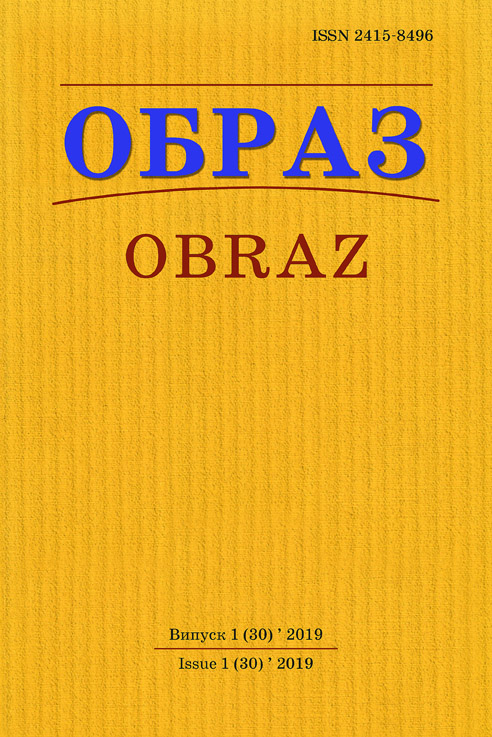Abstract
The purpose of the research is to determine the specificity of the media coverage of the European integration processes in Ukraine by the newspaper «The New York Times». The relevance of the research acknowledges the necessity to adjust the directions of the information and analytical support of Ukraine’s European integration processes at the external level. A thorough analysis of the trends in the process of presentation of the country’s communication arena in the international media is a top priority for both Ukrainian scholars and governmental institutions. The proposed study features an attempt to summarize the specificity of the coverage of Ukrainian events in 2013-2018 by one of the most influential global media - the newspaper “The New York Times” and its online version in particular. The image, formed by the analyzed resource, is impactful both at the global and national levels, which is based upon the citation and influence of nyt.com. The separation and review of each component of this image contributes to a better understanding of the geopolitical processes related to Ukrainian matters. The results demonstrate a significant shift towards the increase in a number of publications and the coverage level of Ukrainian issues after the US elections in 2016.
References
1. Iurishev, A. V. (2013), «Influence of mass media on international public opinion», Fundamentalnyie i prikladnyie issledovaniya v sovremennom mire : materialyi IV Mezhdunarodnoy nauchno-prakticheskoy konferentsii [Fundamental and applied research in the modern world: Proceedings of the IV International Scientific and Practical Conference], December 24–25, 2013, vol. 3, pp. 18–24, available at: http://to-future.ru/wp-content/uploads/2014/01/ ФиПИвСМ_№4_том-3.pdf#page=18 (access Feb 12, 2019).
2. Allendoerfer, M. G. (2017), “Who cares about human rights? Public opinion about human rights foreign policy”, Journal of Human Rights, 16:4, pp. 428–451, DOI: https://doi.org/10.10 80/14754835.2015.1129603.
3. Bogdandy, A., Goldmann, M., and Venzke, I. (2017), «From Public International to International Public Law: Translating World Public Opinion into International Public Authority», European Journal of International Law, vol. 28, issue 1, 1 Feb., pp. 115–145, DOI: https://doi. org/10.1093/ejil/chx002.
4. Quian A., Elías C. Estrategias y razones del impacto de WikiLeaks en la opinión pública mundial // Reis: Revista española de investigaciones sociológicas. –2018. – No. 162. – P. 91–110. DOI: https://doi.org/10.5477/cis/reis.162.91.
5. McCombs, M. (2018), Setting the Agenda: Mass Media and Public Opinion, John Wiley & Sons, New Jersey, 208 p.
6. Tsygankov, P. A. (2008), «Foreign policy and public opinion», Nauchno-analiticheskiy zhurnal Obozrevatel – Observer [Scientific Analytical Journal Observer], no. 7 (222), pp. 36–52, available at: https://elibrary.ru/item.asp?id=13055040 (access Feb 12, 2019).
7. Digital News Report (2018), Reuters Institute for the Study of Journalism, June, available at: https://reutersinstitute.politics.ox.ac.uk/digital-news-report (access Feb 12, 2019).
8. Kennedy, P. J., and Prat, A. (2019), «Where Do People Get Their News?», Economic Policy, Jan. 18, DOI: https://doi.org/10.1093/epolic/eiy016.
9. Potjatynyk, B. (2018), «Quality media: spiral of degradation», Visnyk Lvivskogo universytetu. Serija zhurnalistyka [Visnyk of Lviv University. Journalism series.], 2012, issue 33, pp. 242–248, available at: http://publications.lnu.edu.ua/bulletins/index.php/journalism/ article/viewFile/4314/4349 (access Feb 15, 2019).
10. Kyrylova. O.V. (2016), «The New York Times’ сross-media activities: genesis and modern condition», Visnyk Dnipropetrovskoho universytetu. Seriia «Sotsialni komunikatsii» [Dnipropetrovsk University Bulletin: Social Communications], vol. 24, no. 12, pp. 87–93, available at: https://cct.dp.ua/index.php/journal/article/view/82 (access Feb 15, 2019).
11. Krasnodemska, І. (2017), “Russian-Ukrainian War in the Discourse of the Western Mass Media (2014–2016)”, Ukrainoznavstvo [Ukrainian Studies], no. 4 (65), pp. 67–93, DOI: https:// doi.org/10.30840/2413-7065.4(65).2017.127348.
12. Konev, E. (2017), “New strategies of foreign press in the competitive struggle against electronic media (on example of the New York Times)”, Zamezjnaja jurnalistyka i litaratura [International journalism and literature], pp. 191–194, available at: http://elib.bsu.by/bitstre am/123456789/185692/1/191-194.pdf (access Feb 12, 2019).
13. Puglisi, R. (2011), “Being The New York Times: the Political Behaviour of a Newspaper”, The B.E. Journal of Economic Analysis & Policy, 11(1), DOI: https://doi.org/10.2202/1935- 1682.2025.
14. Usher, N. (2014), Making News at The New York Times, University of Michigan Press, Michigan, 283 p.
15. Gottlieb, J. (2015), “Protest News Framing Cycle: How The New York Times Covered Occupy Wall Street”, International Journal of Communication, vol. 9, available on: https://ijoc. org/index.php/ijoc/article/view/2880 (access Feb 12, 2019).
16. Diakopoulos, N. A. (2015), “The Editor’s Eye: Curation and Comment Relevance on the New York Times”, CSCW ‘15 Proceedings of the 18th ACM Conference on Computer Supported Cooperative Work & Social Computing, pp. 1153–1157, DOI: https://doi.org/10.1145/2675133.2675160.
17. Verbitskaja, O. Yu. (2017), “Analysis of political information in the US media: the modern image of Russia”, Teorii i problem polotocheskih issledovanii [Theories and problems of political studies], vol 6, no. 1А, pp. 39–47, available at: http://publishing-vak.ru/file/archive-politology2017-1/4-verbitskaya.pdf (access Feb 10, 2019).
18. Koshkin, P. G. (2014), “Op-Ed Concept in the New York Times on the Case of Illuminating Events in Russia”, Vestnyk RHHU. Seryia: polytolohyia. Ystoryia. Mezhdunarodnыe otnoshenyia. Zarubezhnoe rehyonovedenye. Vostokovedenye [Vestnik RGGU. Series: Political Science. History. International relations. Foreign regional studies. Oriental studies], no. 18 (140), pp. 194–204, available at: https://elibrary.ru/download/elibrary_22612593_53820016.pdf (access Feb 10, 2019).
19. Yurecheva, E. S. (2012), “Yugoslavia in the coverage of the newspaper “New York Times”: intercultural communication during the crisis of 1990-1991”, Multiculturnyj mir: problema ponimanija [Multicultural world: the problem of understanding], pp. 73–82, available at: https:// elibrary.ru/download/elibrary_22695751_86129434.pdf (access Feb 10, 2019).
20. Mitina, O. V. and Yevdokimova, A. S. (2010), “Text analysis methods: methodological foundations and software implementation”, Vestnyk YuUrHU. Seryia: Psykholohyia [Vestnik YuUrGU. Series: Psychology], no. 40 (216), available at: http://dspace.susu.ru/xmlui/bitstream/ handle/0001.74/3143/3.pdf?sequence=1 (access Feb 18, 2019).
21. Kofman, M. (2017), “For the U.S., Arming Ukraine Could Be a Deadly Mistake”, The New York Times, Aug. 25, available on: https://www.nytimes.com/2017/08/25/opinion/unitedstates-arm-ukraine-missiles.html (access 15.02.2019).
22. Herszenhorn D. M. (2015), “In Ukraine, Corruption Concerns Linger a Year After a Revolution”, The New York Times, May 17, available on: https://www.nytimes.com/2015/05/18/ world/europe/in-ukraine-corruption-concerns-linger-a-year-after-a-revolution.html?_r=4 (access Feb 15, 2019).

This work is licensed under a Creative Commons Attribution 4.0 International License.

